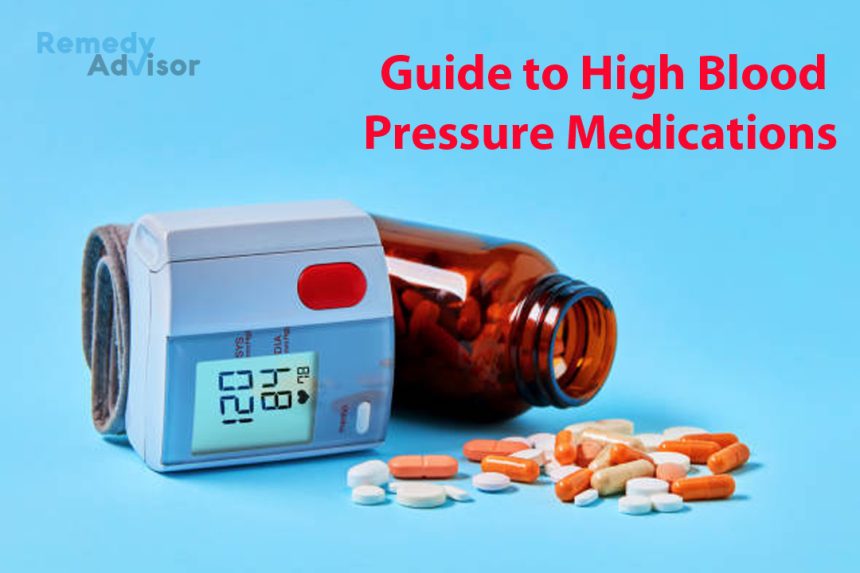When someone has high blood pressure, doctors usually give them medicine if their systolic pressure stays above 160mmHg or their diastolic pressure stays above 100mmHg. There are different kinds of drugs, which are explained in the next section. Some people with high blood pressure only need one drug to control it, but about 10% may need up to three drugs to do so. It’s important to remember that lifestyle changes should be used along with any medications your doctor prescribes. Not only can they reduce or even get rid of the need for drugs, but they can also improve your heart health and quality of life as a whole.
Now let’s talk about the most commonly prescribed medications for high blood pressure and how they might affect you. It’s important to remember that you should never stop taking a prescribed medication without first talking to your doctor, because stopping a medication suddenly can cause serious side effects.
Diuretics
Diuretics, which are also called “water pills,” help the kidneys get rid of water, sodium, and other things through the urine. This process gets rid of extra water and salt in the body, which makes the blood volume smaller. So, the heart can pump blood more effectively, which makes blood pressure go down. Doctors usually give diuretics to people with high blood pressure, heart failure, glaucoma (caused by too much pressure in the eye), and a number of liver and kidney problems.
Diuretics can be especially helpful for people who are sensitive to salt, for African Americans, and for people who eat too much salt.
Types of laxatives
Loop, thiazide, and potassium-sparing diuretics are the three types. Your doctor may give you a prescription for one or more of these medicines at the same time.
Loop diuretics
Loop diuretics like bumetanide (Bumex), furosemide (Lasix), and torsemide (Demadex) don’t have a big effect on blood pressure. But they are often suggested for people who are showing signs of congestive heart failure. If you have congestive heart failure and high blood pressure, your doctor may give you a loop diuretic in addition to other blood pressure-lowering drugs. Loop diuretics make the body lose potassium, water, and sodium. This means that people who take these drugs need to eat more potassium-rich foods or take potassium supplements.
Thiazide diuretics
Thiazide diuretics like chlorothiazide (Diuril), chlorthalidone (generic), hydrochlorothiazide (Esidrix, Microzide), and indapamide (Lozol) are often given to treat high blood pressure and edema caused by heart failure. But it’s important to know that these diuretics may cause side effects like a drop in potassium and an increase in blood sugar and cholesterol. So, if you take a thiazide diuretic, you should pay close attention to these things.
Potassium-sparing diuretics
Potassium-sparing diuretics, like amiloride (brand name Midamor), spironolactone (brand name Aldactone), and triamterene (brand name Maxzidel), are better than other types of diuretics because they keep potassium levels in the body at normal levels. But because they don’t work very well on their own to lower blood pressure, they are often given along with one or two other types of diuretics.
Side Effects of Diuretics
Diuretics can cause weakness, dizziness, nausea, leg cramps, fatigue, gout, high blood sugar (which is especially dangerous for people with diabetes), decreased libido, and trouble getting or keeping an erection. Some people find it bothersome or annoying when diuretics make them have to go to the bathroom more often. If you already have urinary urgency or incontinence (like leaking urine when you cough or sneeze), you might want to talk to your doctor about other ways to treat your condition besides diuretics.
Beta-blockers

Since the 1960s, beta-blockers, which are also called beta-adrenergic blockers, have been a common treatment for high blood pressure and heart disease. These blockers work by stopping neurotransmitters from attaching to beta-receptors, which are found on cells. By doing this, they stop the neurotransmitters from making the heart and blood vessels work harder, which slows down the heart rate and lowers the blood pressure. Your doctor may also give you beta-blockers if you have had a heart attack or arrhythmias.
When someone has high blood pressure, beta-blockers are usually given along with other drugs that treat high blood pressure. When beta-blockers are used with a thiazide diuretic, they work better at treating high blood pressure in African Americans than when they are used alone.
Many sports groups, including the Olympics, the PGA, the US Anti-Doping Agency, and the World Anti-Doping Agency, have banned beta-blockers for athletes or plan to do so in the future. This is because beta-blockers can also calm you down when you’re in a stressful situation, like a sports competition.
Examples of Beta-Blockers
Here are some beta-blockers for treating high blood pressure:
- Atenolol (Tenormin)
- Carvedilol (Coreg)
- Propranolol (Inderal)
- Bisoprolol (Zebeta)
- Nebivolol (Bystolic)
- Metoprolol (Lopressor and Toprol XL)
- Timolol (Blocadren)
- Labetalol (Trandate)
- Nadolol (Corgard)
- Pindolol (Visken)
- Sotalol (Betapace)
Side Effects of Beta-Blockers
If you have a long-term lung condition like asthma, beta-blockers could make the condition worse. In a strange way, beta-blockers may make heart failure more likely in some people while making it less likely in others. Studies also show that taking older beta-blockers like atenolol, metoprolol, and propranolol could increase the risk of type 2 diabetes by more than 25%. Some common side effects are tiredness, depression, less ability to exercise, trouble getting an erection, shortness of breath, and trouble sleeping.
Alpha-2 agonists
The alpha-2 agonist drugs, which are also called centrally acting alpha agents, work differently than other drugs used to lower high blood pressure. They work in the brain by stopping the process that makes blood vessels narrow. Some of the drugs in this group are used to treat pregnant women with high blood pressure.
Examples of Alpha-2 Agonists
If your doctor gives you a prescription for an alpha-2 agonist, you have a few choices. In the “Side Effects of Alpha-2 Agonists” section, it’s important to remember that each drug may have different side effects.
- Alpha-methyldopa (Aldomet)
- Clonidine (Catapres)
- Guanabenz (Wytensin)
- Guanfacine (Tenex)
Side Effects of Alpha-2 Agonists
All four of the mentioned alpha-2 agonists have the same side effects, which are trouble with sexual function and feeling sleepy. Alpha-methyldopa can also cause sluggishness, dry mouth, fever, anemia, and a big drop in blood pressure when you stand up or walk. The last three medicines are more likely to make you feel very sleepy, have a dry mouth, or have trouble going to the bathroom.
Angiotensin-converting enzyme (ace) inhibitors
ACE inhibitors stop angiotensin-converting enzyme from making inactive angiotensin I into active angiotensin II. This is why they are called “ACE inhibitors.” The blood pressure goes up because of this change. By stopping this enzyme from working, ACE inhibitors keep the kidneys from holding on to salt and water, which lowers blood pressure. Most of the time, ACE inhibitors work well to treat high blood pressure and have fewer side effects than other drugs. They also help people with congestive heart failure, kidney problems, or diabetes keep their hearts and kidneys healthy.
One problem with ACE inhibitors is that when used alone, they don’t work as well for African Americans. But when they are taken with a thiazide diuretic, they work better.
Examples of ACE Inhibitors
Here are some ACE inhibitors your doctor might give you:
- Quinapril (Accupril)
- Captopril (Capoten)
- Trandolapril (Mavik)
- Fosinopril (Monopril)
- Lisinopril (Prinivil, Zestril)
- Benazepril (Lotensin)
- Enalapril (Vasotec)
- Ramipril (Altace)
Side Effects of ACE Inhibitors
Some of the most common side effects of ACE inhibitors are a dry cough and a reduced ability to taste. If you have kidney problems, you should be careful when taking ACE inhibitors because they can cause potassium to build up in your body.
Calcium channel blockers
Calcium channel blockers work to lower high blood pressure by stopping calcium from getting into the heart muscle cells and arteries. Because of this, the heart’s contractions get weaker and the blood vessels get bigger. This makes the heart pump blood more efficiently and lowers blood pressure.
Examples of Calcium Channel Blockers
- Amlodipine (Norvasc)
- Bepridil (Vascor)
- Diltiazem (Cardizem)
- Felodipine (Plendil)
- Isradipine (DynaCirc)
- Nicardipine (Cardene)
- Nifedipine (Adalat, Procardia)
- Nimodipine (Nimotop)
- Nitrendipine (Cardif, Nitrepin)
- Pranidipine (Acalas)
- Verapamil (Calan, Isoptin)
Side Effects of Calcium Channel Blockers
If you take calcium channel blockers, you might have side effects like constipation, nausea, heartburn, headache, slow heart rate (bradycardia), gum problems, and water retention (edema). If you are taking calcium channel blockers, it is best not to eat grapefruit or drink grapefruit juice.
Angiotensin ii receptor blockers (arbs)
One of the newer ways to treat high blood pressure is with drugs called angiotensin II receptor blockers (ARBs). Angiotensin is a chemical in the body that can raise blood pressure. These medicines work by blocking the effects of angiotensin. If you can’t take ACE inhibitors, your doctor may tell you to take ARBs instead.
Examples of ARBs
- Candesartan (Atacand)
- Eprosartan (Tevetan)
- Irbesartan (Avapro)
- Losartan (Cozaar)
- Olmesartan (Benicar)
- Telmisartan (Mycardis)
- Valsartan (Diovan)
Side Effects of ARBs
If your doctor prescribes ARBs, you might have back or leg pain, confusion (call your doctor right away), diarrhea, dizziness, fainting (most likely after the first dose), trouble sleeping, an irregular heartbeat, muscle spasms, sinus inflammation, or an upper respiratory infection.
Combining medications

Many doctors tell people with high blood pressure to take more than one antihypertensive drug. People with resistant hypertension often have to take three or more medications to keep their blood pressure in check.
Patients with stage 1 hypertension are usually given one drug at the lowest possible dose. The dose is slowly increased until a healthier range is reached, which is usually less than 140/90 mmHg or less than 130/80 mmHg for those with diabetes or kidney disease. If the blood pressure doesn’t go down, a second drug might be given. It is important to remember that antihypertensive medications should always be taken with changes in lifestyle.
Drug companies sell both single-ingredient drugs and combination prescription drugs that have two different types of drugs in them. This means that patients only have to take one drug instead of two. The two drugs work together to lower blood pressure in two different ways. Also, a single combination drug can treat both high blood pressure and other health problems, like heart disease, effectively. This makes it easier for patients to take their medicines as prescribed, which improves patient compliance.
There are a number of antihypertensive drugs that can be taken together. The most common ones are two types of diuretics, such as hydrochlorothiazide with either a beta blocker, an ACE inhibitor, or an ARB.
- Amiloride plus hydrochlorothiazide: Moduretic
- Triamterene plus hydrochlorothiazide: Dyazide
- Prazosin plus polythiazide: Minizide
- Tenoretic (Atenolol plus Chlorthalidone):
- Lopressor HCT is made up of metoprolol and hydrochlorothiazide.
- Enalapril and hydrochlorothiazide: Vaseretic
- Captopril plus hydrochlorothiazide: Capozide
- Candesartan and hydrochlorothiazide: Atacand HCT
- Losartan plus hydrochlorothiazide: Hyzaar
- Valsartan plus hydrochlorothiazide: Diovan HCT
- Amlodipine plus benazepril: Lotrel
- Diltiazem plus enalapril: Teczem
- Methyldopa plus hydrochlorothiazide: Aldoril
- Amlodipine plus valsartan: Exforge
- Amlodipine plus olmesartan: Azor
When two or more drugs are taken together, the side effects often include the bad effects of both drugs. We talked about the side effects of each part of the combination medicine earlier in the chapter.







